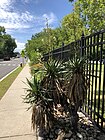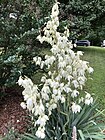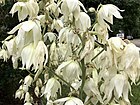Note: This is a project under development. The articles on this wiki are just being initiated and broadly incomplete. You can Help creating new pages.
Difference between revisions of "Yucca filamentosa"
(Created page with "{{stub}} ==Uses== {{Uses|}}, {{Uses|}}, {{Uses|}}, {{Uses|}}, {{Uses|}}, {{Uses|}}, {{Uses|}}, {{Uses|}}, {{Uses|}}, {{Uses|}}, {{Uses|}}. ==Parts Used== {{Parts Used|}}, {{...") |
|||
| (One intermediate revision by the same user not shown) | |||
| Line 1: | Line 1: | ||
| − | + | [[File:Agave.june.2018.jpg|thumb|right]] | |
| − | + | '''Yucca filamentosa''' is an evergreen shrub producing a rosette of spear-shaped leaves 50 - 75cm long and 2 - 4cm wide from a long, thick, mainly underground stem with a very short, unbranched, above-ground stem up to 50cm tall. The plant forms a cluster of rosettes plus one or more flowering stems up to 4.5 metres tall. | |
==Uses== | ==Uses== | ||
| − | {{Uses|}}, {{Uses|}}, {{Uses|}}, {{Uses|}}, {{Uses|}}, {{Uses|}}, {{Uses|}}, {{Uses|}}, {{Uses|}}, {{Uses|}}, {{Uses|}}. | + | {{Uses|Low blood pressure}}, {{Uses|Osteoarthritis}}, {{Uses|Swelling}}, {{Uses|Hypertension}}, {{Uses|Migraine headaches}}, {{Uses|Colitis}}, {{Uses|Stomach disorders}}, {{Uses|Hypercholesterolemia}}, {{Uses|Diabetes}}, {{Uses|Poor circulation}}, {{Uses|Gallbladder disorders}}. |
==Parts Used== | ==Parts Used== | ||
| − | {{Parts Used|}}, {{Parts Used| | + | {{Parts Used|Fruits}}, {{Parts Used|Flowers}}, {{Parts Used|Flowering stem}}. |
==Chemical Composition== | ==Chemical Composition== | ||
| − | <ref name="chemical composition"/> | + | It contains phenolic constituents of Y. schidigera etc.<ref name="chemical composition"/> |
==Common names== | ==Common names== | ||
| Line 17: | Line 17: | ||
===Dravya=== | ===Dravya=== | ||
===Rasa=== | ===Rasa=== | ||
| − | |||
===Guna=== | ===Guna=== | ||
| Line 30: | Line 29: | ||
==Habit== | ==Habit== | ||
| − | {{Habit|}} | + | {{Habit|Evergreen shrub}} |
==Identification== | ==Identification== | ||
| Line 49: | Line 48: | ||
==Mode of Propagation== | ==Mode of Propagation== | ||
| − | {{Propagation|}} | + | {{Propagation|Seeds}} |
==How to plant/cultivate== | ==How to plant/cultivate== | ||
| − | <ref name="How to plant/cultivate"/> | + | Yucca filamentosa is a plant of semi-arid regions in southern N. America and can tolerate occasional short-lived temperatures down to around -15°c.<ref name="How to plant/cultivate"/> |
==Commonly seen growing in areas== | ==Commonly seen growing in areas== | ||
| − | {{Commonly seen|}}, {{Commonly seen|}}, {{Commonly seen| | + | {{Commonly seen|Sand dunes}}, {{Commonly seen|Waste ground}}, {{Commonly seen|Pine forests along the coastal plain}}. |
==Photo Gallery== | ==Photo Gallery== | ||
<gallery class="left" caption="" widths="140px" heights="140px"> | <gallery class="left" caption="" widths="140px" heights="140px"> | ||
| + | 2018-06-20 11 59 43 A yucca along New Jersey State Route 439 (North Avenue) near New Jersey Route 82 (Morris Avenue) at Kean University in Union Township, Union County, New Jersey.jpg | ||
| + | |||
| + | |||
| + | 2019-06-12 07 56 21 A Yucca flowering along Indale Court in the Franklin Farm section of Oak Hill, Fairfax County, Virginia.jpg | ||
| + | |||
| + | |||
| + | 2019-06-12 07 56 27 Yucca flowers along Indale Court in the Franklin Farm section of Oak Hill, Fairfax County, Virginia.jpg | ||
| + | |||
| + | |||
| + | 2019-06-12 07 56 33 Yucca flowers along Indale Court in the Franklin Farm section of Oak Hill, Fairfax County, Virginia.jpg | ||
| + | Agave.june.2018.jpg | ||
</gallery> | </gallery> | ||
| Line 65: | Line 75: | ||
<references> | <references> | ||
| − | <ref name="chemical composition">[ | + | <ref name="chemical composition">[https://link.springer.com/article/10.1007/s11101-005-1234-5 Chemical constituents]</ref> |
| − | <ref name="Leaf">[ | + | <ref name="Leaf">[Morphology]</ref> |
| − | <ref name="How to plant/cultivate">[ | + | <ref name="How to plant/cultivate">[http://temperate.theferns.info/plant/Yucca+filamentosa Cultivation]</ref> |
</references> | </references> | ||
==External Links== | ==External Links== | ||
| − | * [ ] | + | * [http://www.missouribotanicalgarden.org/PlantFinder/PlantFinderDetails.aspx?kempercode=c287 Yucca filamentosa on missouribotanicalgarden.org] |
| − | * [ ] | + | * [https://www.wildflower.org/plants/result.php?id_plant=YUFI Yucca filamentosa on wildflower.org] |
| − | + | ||
[[Category:Herbs]] | [[Category:Herbs]] | ||
Latest revision as of 16:05, 7 September 2020
Yucca filamentosa is an evergreen shrub producing a rosette of spear-shaped leaves 50 - 75cm long and 2 - 4cm wide from a long, thick, mainly underground stem with a very short, unbranched, above-ground stem up to 50cm tall. The plant forms a cluster of rosettes plus one or more flowering stems up to 4.5 metres tall.
Contents
- 1 Uses
- 2 Parts Used
- 3 Chemical Composition
- 4 Common names
- 5 Properties
- 6 Habit
- 7 Identification
- 8 List of Ayurvedic medicine in which the herb is used
- 9 Where to get the saplings
- 10 Mode of Propagation
- 11 How to plant/cultivate
- 12 Commonly seen growing in areas
- 13 Photo Gallery
- 14 References
- 15 External Links
Uses
Low blood pressure, Osteoarthritis, Swelling, Hypertension, Migraine headaches, Colitis, Stomach disorders, Hypercholesterolemia, Diabetes, Poor circulation, Gallbladder disorders.
Parts Used
Fruits, Flowers, Flowering stem.
Chemical Composition
It contains phenolic constituents of Y. schidigera etc.[1]
Common names
| Language | Common name |
|---|---|
| Kannada | |
| Hindi | |
| Malayalam | |
| Tamil | |
| Telugu | |
| Marathi | |
| Gujarathi | |
| Punjabi | |
| Kashmiri | |
| Sanskrit | |
| English |
Properties
Reference: Dravya - Substance, Rasa - Taste, Guna - Qualities, Veerya - Potency, Vipaka - Post-digesion effect, Karma - Pharmacological activity, Prabhava - Therepeutics.
Dravya
Rasa
Guna
Veerya
Vipaka
Karma
Prabhava
Habit
Identification
Leaf
| Kind | Shape | Feature |
|---|---|---|
Flower
| Type | Size | Color and composition | Stamen | More information |
|---|---|---|---|---|
| {{{5}}} |
Fruit
| Type | Size | Mass | Appearance | Seeds | More information |
|---|---|---|---|---|---|
Other features
List of Ayurvedic medicine in which the herb is used
Where to get the saplings
Mode of Propagation
How to plant/cultivate
Yucca filamentosa is a plant of semi-arid regions in southern N. America and can tolerate occasional short-lived temperatures down to around -15°c.[3]
Commonly seen growing in areas
Sand dunes, Waste ground, Pine forests along the coastal plain.
Photo Gallery
References
- ↑ Chemical constituents
- ↑ [Morphology]
- ↑ Cultivation
External Links
- Ayurvedic Herbs known to be helpful to treat Low blood pressure
- Ayurvedic Herbs known to be helpful to treat Osteoarthritis
- Ayurvedic Herbs known to be helpful to treat Swelling
- Ayurvedic Herbs known to be helpful to treat Hypertension
- Ayurvedic Herbs known to be helpful to treat Migraine headaches
- Ayurvedic Herbs known to be helpful to treat Colitis
- Ayurvedic Herbs known to be helpful to treat Stomach disorders
- Ayurvedic Herbs known to be helpful to treat Hypercholesterolemia
- Ayurvedic Herbs known to be helpful to treat Diabetes
- Ayurvedic Herbs known to be helpful to treat Poor circulation
- Ayurvedic Herbs known to be helpful to treat Gallbladder disorders
- Herbs with Fruits used in medicine
- Herbs with Flowers used in medicine
- Herbs with Flowering stem used in medicine
- Habit - Evergreen shrub
- Index of Plants which can be propagated by Seeds
- Herbs that are commonly seen in the region of Sand dunes
- Herbs that are commonly seen in the region of Waste ground
- Herbs that are commonly seen in the region of Pine forests along the coastal plain
- Herbs





